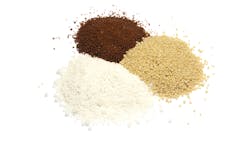Water treatment waste helps circular economies
Two European projects focusing on recycling water treatment wastes are both expanding, offering lessons on the importance of scale in a circular economy.
AquaMinerals in the Netherlands and Seitiss in France have both witnessed significant growth in turning wastes into valuable resources, according to the KWR Water Research Institute. Both developments have enabled resources from drinking water treatment or industrial processes to be sold and reused, connecting supply and demand over a nationwide scale.
It comes at a time of increasing focus on a circular economy across Europe. The European Commission’s adoption of the circular economy action plan (CEAP) means circular economies have become a central building block in continent’s drive for sustainable growth.
Riding the cascade in circularity
“There’s been a cascade in circularity,” said Olaf van der Kolk, CEO of AquaMinerals. “While the drinking water companies already have developed numerous mature value chains, for wastewater it's still developing.”
“If you look at the recovery of valuable resources, like struvite, phosphorus, cellulose, sand or methane from the process itself, wastewater has enormous possibilities,” added the CEO.
The spark for AquaMinerals started over 25 years ago when Dutch drinking water utilities came together to address how to treat their solid wastes and founded the company. Produced sludges and other solids were collected to be transformed into valuable materials, economically and environmentally, for industries, the agricultural sector and sometimes the water sector itself.
Balancing supply and demand
Today, AquaMinerals reclaims and resells circular products including calcite, removed during the drinking water softening process. Part of the secret to its growth is scale: the organization operates nationally, connecting the water companies’ residuals to the end markets as the circular broker.
“If you have the volumes of resources to deliver to multiple locations, this can drive a tremendous impact on the market,” added van der Kolk. “On the other hand, if you have a pilot plant producing one truckload every two months, that’s interesting from a research or demonstration point of view but lacks scale.”
Security of supply is incredibly important when it comes to the circular economy. For example, AquaMinerals provides iron from the drinking water companies to the digestion industry, converting biomass into methane. Depending on the contract, iron must be supplied within 24 or 72 hours after being ordered by the digester.
“They are dependent on this iron,” he adds. "If this iron is not there, it could cause huge damage to the installation due to (sulphur-) corrosion. We have over 80 production sites across the Netherlands and Belgium where we collect the iron, as well as keep the resources to store the iron externally so that we can meet this order."
Creating sustainable industrial synergies in France
AquaMinerals is also targeting markets beyond the Netherlands and Belgium. As part of the H2020 NextGen collaboration, it is in dialogue with Strane Innovation in France, which aims to create start-ups based on EU project outputs.
Charles-Xavier Sockeel, a sustainable business engineer from the organization, believes that we need to make sure the environment and ecosystem are ready for circularity to thrive.
“We facilitate researchers to find a market and then identify which key exploitation results are important. From this, we see if it's feasible to generate a spin-off start-up and whether the market is mature enough to handle it,” he said.
One notable circular development from Strane is Seitiss, designed to create “industrial synergies” by linking French industries. To date, 160 processes have been studied over 18 industries, resulting in over 3000 characterized resources. The result? A total of 500 “documented synergies and 20,000 resource matches” over 33,000 geolocated sites.
“We help to connect sectors: what is considered waste from one sector is a resource to another,” adds Sockeel. “Using GIS tools, we look for other actors to join the first step of this ecosystem so that we strengthen the value chains nationally.”
Like AquaMinerals in the Netherlands, Seitiss acts as a circular broker in France, connecting to ensure resource buyers have a sustainable supply in the right quantities.
SOURCE: KWR Water Research Institute
